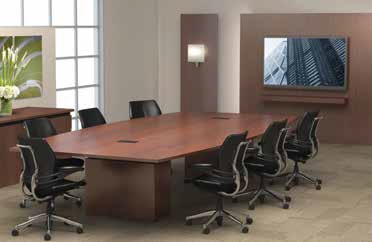As the demand for corporate collaboration technology continues to grow, huddle spaces—small, tech-equipped areas for informal meetings—remain one of the most popular applications in this innovation wave. But with the ever-expanding range of products available to equip them, integrators can get caught up in the complexity of specifying the ideal package. So what are companies doing to help integrators select optimized solutions? And how are software and hardware coming together to provide a complete huddle-room package?
Middle Atlantic Products
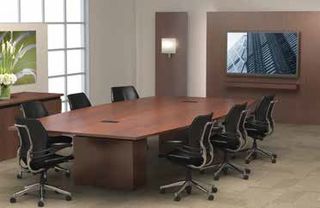
Middle Atlantic’s TechPed technology pedestal. “First, identify your client’s specific requirements. How many users, and will they be sitting or standing? Is the setting for collaboration or video teleconference? And how much room do you have to work with? Today’s clients are requesting more capabilities in smaller spaces, requiring the ability to mount equipment securely under tables, in the ceiling, and behind the display. Furniture such as our C5 credenza, L5 lectern, and TechPed technology pedestal offer ideal solutions.
“Of course, hardware and software are important considerations, but an installation is only as good as the foundation it’s built on—and end users typically aren’t concerned with technology distinctions. They don’t care how or where the magic happens as long as it happens—easily, consistently, and reliably. Therefore, it’s important to choose the right solutions that meet the aesthetic needs as much as the technology needs. Furniture solutions, like our Frame to Furniture line, allow for visual updates without a complete replacement. This minimizes hassle and expense for both the integrator and the end user.”
—Timothy Troast, director, product management, Middle Atlantic Products
Sony
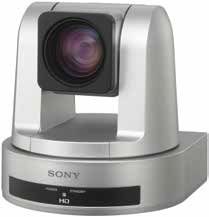
Sony’s SRG-120DU camera. “Integrators must weigh several key factors when selecting equipment for huddle spaces such as camera position, distance from lens to object, lighting, and most importantly, ensuring the equipment is compatible with the clients’ VC software. As the use of traditional hardware codecs declines, the desire to use software clients on laptops and PCs increases.
“Designed specifically for visual communications, Sony’s high-sensitivity SRG-120DU USB3.0 PTZ camera provides plug-and-play simplicity with superb image quality. The SRG-120DU’s USB.30 UVC video compatibility assures connectivity with today’s popular desktop videoconferencing clients such as Skype for Business and Vidyo’s Desktop for instant collaboration and video communication. The camera’s wide field of view (71 degrees) and 12x AF lens also makes it ideal for huddle spaces and easily converts any room into a professional collaboration environment.”
—Terry Huber, senior marketing manager, Remote Communications Division, Sony Electronics
Vaddio
“Software and hardware solutions are coming together to enable professional audiovisual integrators to outfit huddle spaces in a more efficient manner, allowing customers greater flexibility and easy-to-use solutions. With professional quality audio and video products, like Vaddio’s RoboSHOT 12 USB, ClearSHOT 10 USB, and Mixer/AMP with table or ceiling mic options, users are now able to turn their computer, or any computer, into their conferencing backbone.
“Previously, outfitting huddle spaces with videoconferencing gear was cost-prohibitive; today it’s almost second nature. Integrators are able to design systems and solutions that are agnostic to current infrastructure. Whether Skype for Business, GoToMeeting, Google Hangouts, or myriad other platforms, users can choose their solution without worrying about their hardware supporting it.”
—Mike Brandes, applications engineer, Vaddio
InFocus
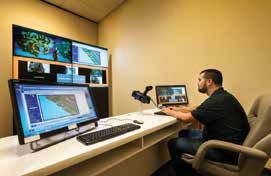
InFocus’ Jupiter Canvas solution offers flexibility and convenient usage on a wide variety of devices and video walls. “At face value, huddle space technology includes a consistent set of components: screens, network connections, and the ability to pull and display different types of data feeds in a meaningful way. And yet, every customer will have a different use case for this technology. Some will require the ability to simultaneously view routine video streams and data from around the world within a broad and complex network to conceptualize what is going on at any time. Others may need to quickly intervene in an emerging situation—requiring the collaborative input and spontaneous data feeds of experts in multiple time zones using multiple devices.
“Software-based solutions driving integrated hardware components purpose built for each scenario is not only possible, but necessary. Such systems offer flexibility and convenient usage on a wide variety of devices and video walls. The key is making crucial visual information available to the right people, anywhere, any time, and on whatever device they have in front of them.”
— Brady O. Bruce, vice president of marketing, InFocus
Kramer
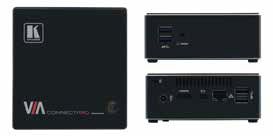
Kramer’s VIA Connect Pro system. “Integrators today have a wide range of wireless presentation and collaboration solutions to offer clients with huddle spaces. These solutions are more and more software-based as the merger of AV and IT marches along. Some huddle space users simply need to connect all participants quickly and effortlessly switch between displaying different meeting participants screens. This represents the entry level of wireless presentation solutions.
“One important consideration at this entry level is video quality. Most solutions in this range employ ‘screen scraping,’ which means they display only a limited number of video frames per second, creating chopping video. A better solution is a device that can provide smooth, full frame-rate video. Other huddle space users will require collaboration tools in addition to wireless presentation capability. Collaboration tools to look for today include immediate file sharing, whiteboard functions, use of third-party apps such as video conferencing, and more.”
—Clint Hoffman, vice president of marketing, Kramer Electronics US
Ricoh
“Over the past few years we’ve experienced a shift in corporate meeting spaces’ size, design, and scope. The focus was previously on large conference rooms loaded with collaboration equipment. However, only a limited number of people had access to these rooms. Today, as how we work evolves with the rise of remote and cross-functional teams, the trend favors providing many smaller meeting spaces that offer more people access to collaboration tools.
“Products like interactive whiteboards, portable video conferencing systems, and interactive projectors have grown in demand to support ‘huddle rooms’ and foster richer collaboration. People show up for a meeting with laptops, tablets, and phones that all need to be connected and displayed quickly and easily; there’s no time for collaboration to get gridlocked by technical issues. Ultimately, this shift is all about making meetings and people more productive and efficient. I don’t see that trend or need ever going away.”
— Paul Foschino, senior manager, Visual Communications Group, Ricoh Americas
Epson
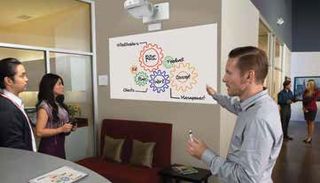
Epson’s BrightLink Pro collaboration platform. “Because huddle spaces are often used for impromptu meetings with no prep work, no presentation, and no agenda, integrators need to take into consideration the technology they install should be flexible and easy to use. Solutions designed for huddle spaces such as the Epson BrightLink Pro support PC-free digital whiteboarding, BYOD for collaborating on users’ content on their own devices, and the ability to share notes easily. Solutions such as this are ideal for huddle space meetings: they turn a dry-erase board, wall, or a table into an interactive display that can be used intuitively.
“As collaboration technology becomes more commonplace, manufacturers are working to create the most efficient and productive user experience possible by developing hardware solutions that either include software or can easily integrate with third-party software that companies have already implemented.”
—Sean Gunduz, senior product manager, Epson America
ClearOne
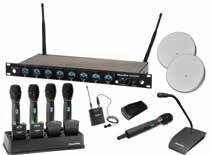
ClearOne’s family of microphone systems. “Corporate and educational organizations’ requirements for flexible meeting spaces apply both to individual room arrangements, and to divisible meeting spaces. This creates challenges for AV systems, including microphone systems. Using wireless microphones allows easier movement of the microphones in dynamically changing environments. However, managing the microphones in a cost-effective way that does not strand wireless system resources in unused spaces is difficult. Ideally, you should be able to use any of the microphones in any space they are needed.
“The Clearone WS800 digital wireless microphone system is the proven solution to this challenge, as our product allows a single WS800 system to cover from one to six meeting spaces. A standard touchpanel control and room integration system can assign microphones to specific spaces for specific meetings. Other systems can be added as needed at up to 128 channels per space. This greatly increases the value of the client’s wireless investment.”
— John Nygren, sales director, Wireless Microphone Solutions, North and Central America, ClearOne
Barco
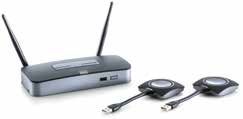
Barco’s ClickShare CSM unit for huddle spaces. “In contrast to existing conferencing rooms, huddle spaces are small gathering spots where people can quickly come in without reservation and easily conduct their business discussion among a few people. With that in mind, the BYOD requirement is even more important, so integrators need to look for technology, like the Barco ClickShare Presentation System, that enables attendees to utilize their devices such as smartphones, tablets, and laptops. This will also allow the huddle space to become a hassle-free environment by releasing attendees from cabling and adapter issues, as well as not requiring software downloads.
“Lastly, look at leveraging tools like ClickShare that offer the choice of a stand-alone Wi-Fi connection for collaboration, or the ability to integrate into the network infrastructure if they choose that route.”
—David Fitzgerald, vice president of channel sales, Barco
X2O
“The huddle room is a center where employees bring their own devices of choice, be it laptops, tablets, or mobile phones. To maximize productivity and employee engagement, organizations must deploy the simplest method for connecting all devices and enabling collaboration. In turn, integrators must consider these key factors when selecting huddle-space solutions: ease of use, quality of audio and video, and connectivity. Another important consideration is making sure all endpoints support all necessary standards and applications, now and in the future.
“Complexity is the biggest barrier to adoption; therefore, systems must offer simple operation and reliable performance every time. When ease of use is augmented with connected-desktop applications such as those X2O provides, employees can review real-time BI dashboards, conduct polls, and share desktop channels of information, even when not physically present in the huddle room. An essential aspect of the meeting is that collaborators act upon the key issues discussed, even after the meeting is over.”
— Neal Evan Caminsky, director of product marketing, Barco X2O
Biamp Systems
“Today’s workers have an amazing range of technology at their fingertips at all times — meaning their preferences in the workplace are changing. Enterprises need to accommodate these expectations and requirements to ensure that collaboration continues to flourish. For integrators this means designing solutions that are forward compatible and can work with innovative brands for smoother transitions. As collaboration continues to increase around the world, huddle rooms, collaboration platforms, and premium audio technology are becoming everyday work tools.
“Through the convergence of hardware and software solutions, integrators should design solutions that provide participants with straightforward control of every aspect in the collaborative process, including the ability to control and communicate from mobile devices, which makes communication even easier since it leverages familiar technology.”
— Sally Blank, sales development director for Unified Communications, Biamp Systems
Extron
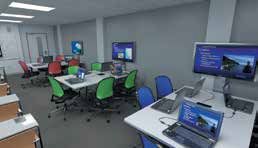
The Extron TeamWork systems are complete integrated solutions for meeting spaces that allow anybody to enter a meeting room, connect their device to our “Show Me” cables, and begin presenting their content. “When selecting an AV solution for huddle spaces, you need to ensure it works well across multiple device platforms—Windows, Andriod, iOS, etc.—in order to support whatever laptop, tablet, or smartphone the participant may want to use. Sources that output 4K video will also become more common and huddle spaces will need to support them. Understanding the intention for the huddle room will also help you determine the size of the display and the typical viewing distance. Another challenge is being able to support the connections to the display, either through wired or wireless connections.
“The Extron TeamWork systems are complete integrated solutions for meeting spaces that allow anybody to enter a meeting room, connect their device to our “Show Me” cables, and begin presenting their content. For people interested in a wireless solution, the ShareLink 200 allows mobile devices like laptops or tablets to wirelessly present content on a flat panel display or projector.
—Joe da Silva, director of product marketing, Extron
FSR
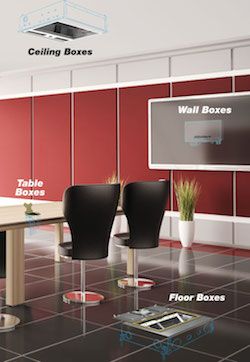
FSR offers a variety of solutions to enable flexibility of uses. “To properly assess the options available to a client, integrators should start with a conversation about the intended use of the space and any variables to determine the best equipment fit. Will this room encourage BYOD? How many individuals will it hold? Is videoconferencing required? What is the client’s IT policy for wired versus wireless equipment and connectivity? Answering these questions will help narrow the field of complementary equipment for the huddle space.“We are seeing a lot of installations where huddle rooms are outfitted with a hybrid of software and hardware solutions. The combination enables greater flexibility regarding the use of the rooms. Huddle spaces are not exclusively used for a 15-minute group-work huddle any longer, but are now being used as general, small-group collaborative work places that can include a variety of activities like video conferencing, content modification, capture, and more!”
—Gina Sansivero, director of business development, education, FSR
